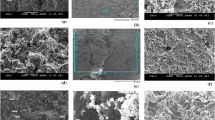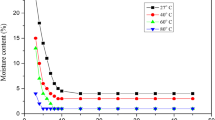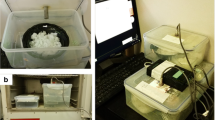Abstract
A laboratory model of a forced circulation desiccant based green pea drying system operating in an open-loop is constructed and tested. The green pea drying process is divided into two stages involving dehumidification by the desiccant bed and green peas drying by dehumidified process air. Removal of moisture from the process air has been achieved by vertical packed composite desiccant beds. The composite desiccant used are heat treated clay with CaCl2 being impregnated and clay with additives like horse dung and sawdust, again being heated, treated and later impregnated with CaCl2. The green peas were dried for a process time of one hour. The drying was quite sharp during the initial process time of 500 s and from then onwards proceeded at a constant rate. For the identical bed masses, The performance of heat treated clay-additives based beds in moisture reduction and enhancement in enthalpy of process air is higher. The experimental study reveals the average heat content of air entering the dryer is 1.46, 2.46 and 2.38 kJ for heat-treated clay-CaCl2, clay-horse dung-CaCl2 and clay-sawdust-CaCl2 composite desiccant beds of 700 g mass.













Similar content being viewed by others
Abbreviations
- \(A_{sf}\) :
-
Surface area of desiccant bed (m2)
- \(d_{p}\) :
-
Diameter of spherical shaped desiccant (m)
- \(dr\) :
-
Drying rate (g/kg s-1)
- \(dt\) :
-
Time interval (s)
- \(t_{d}\) :
-
Total process time (min)
- \(Mr\) :
-
Overall moisture removed (g/min)
- \(D\) :
-
Desiccant bed diameter (m)
- \(G\) :
-
Reduction in grain mass (g)
- \(h\) :
-
Enthalpy of humid air (kJ)
- \(L\) :
-
Desiccant bed length (m)
- \(m\) :
-
Moisture transferred (%)
- \(W\) :
-
Air humidity ratio (g/kg)
- \(w\) :
-
Mass of sample (g)
- \(t\) :
-
Process time (s)
- \(T_{{}}\) :
-
Temperature (°C)
- \(P\) :
-
Pressure (Pa)
- \(V\) :
-
Volume (m3)
- \(v_{s}\) :
-
Superficial velocity (m/s)
- \(X\) :
-
Manometer deflection (m)
- \(a\) :
-
Air
- \(b\) :
-
Desiccant bed
- \(d\) :
-
Desiccant
- \(i\) :
-
Inlet
- \(e\) :
-
Exit
- \(g\) :
-
Grain
- \(v\) :
-
Vapor
- \(sat\) :
-
Saturation
- \(\rho\) :
-
Density (kg/m3)
- \(\mu\) :
-
Viscosity (kg/ms)
- \(\varepsilon\) :
-
Porosity (%)
- \(db\) :
-
Desiccant bed
- \(gd\) :
-
Grain bed
- \(RH\) :
-
Relative humidity
- \(CL\) :
-
Clay
- \(HD\) :
-
Horse dung
- \(SD\) :
-
Sawdust
References
Kumar D. and Kalita P. 2017 Reducing postharvest losses during storage of grain crops to strengthen food security in developing countries; Foods 6 1–22
Mujumdar A. S. and Law C. L. 2010 Drying technology: trends and applications in postharvest processing; Food Bioprocess. Technol. 3 843–852
Misha S., Mat S., Ruslan M. H. and Sopian K. 2012 Review of solid/liquid desiccant in the drying applications and its regeneration methods; Renew. Sustain. Energy Rev. 16 4686–4707
El-Sebaii A. A. and Shalaby S. M. 2013 Experimental investigation of an indirect-mode forced convection solar dryer for drying thymus and mint; Energy Convers. Manag. 74 109–116
Doymaz İ and Kocayigit F. 2011 Drying and rehydration behaviors of convection drying of green peas; Dry. Technol. 29 1273–1282
Dina S. F., Ambarita H., Farel H. N. and NapitupuluKawai F. H. H. 2015 Study on effectiveness of continuous solar dryer integrated with desiccant thermal storage for drying cocoa beans; Case Stud. Therm. Eng. 5 32–40
Mahdiyeh D., Mortezapour H., Akhavan H. R. and Moghaddam A. G. 2018 Tomato slices drying in a liquid desiccant-assisted solar dryer coupled with a photovoltaic-thermal regeneration system; Sol. Energy 162 364–371
Hanif S., Sultan M., Miyazaki T. and Koyama S. 2019 Investigation of energy-efficient solid desiccant system for wheat drying; Int. J. Agric. Biol. Eng. 12 221–228
Thoruwa T. F. N., Grant A. D., Smith J. E. and Johnstone C. M. 1998 A solar-regenerated desiccant dehumidifier for the aeration of stored grain in the humid tropics; J. Agric. Eng. Res. 71 257–262
Shanmugam V. and Natarajan E. 2006 Experimental investigation of forced convection and desiccant integrated solar dryer; Renew. Energy 31 1239–1251
Nagaya K., Li Y., Jin Z., Fukumuro M., Ando Y. and Akaishi A. 2006 Low-temperature desiccant-based food drying system with airflow and temperature control; J. Food Eng. 75 71–77
Hung B. N., Nuntaphan A. and Kiatsiriroat T. 2009 Integration of desiccant tray unit with internal cooling for aeration of paddy silo in humid tropical climate; Biosyst. Eng. 102 75–82
Hodali R. and Bougard J. 2001 Integration of a desiccant unit in crops solar drying installation: optimization by numerical simulation; Energy Convers. Manag. 42 1543–1558
Rajamani M., Mishra V. R. and Maliyekkal S. M. 2017 Bundled-firewood like AlOOH-CaCl2 nanocomposite desiccant; Chem. Eng. J. 323 171–179
Mbuge D. O., Negrini R., Nyakundi L. O., Kuate S. P., Bandyopadhyay R., Muiru W. M. and Mezzenga R. 2016 Application of superabsorbent polymers (SAP) as desiccants to dry maize and reduce aflatoxin contamination; J. Food Sci. Technol. 53 3157–3165
Subramanyam N., Maiya M. P. and Murthy S. S. 2004 Application of desiccant wheel to control humidity in air-conditioning systems; Appl. Therm. Eng. 24 2777–2788
Kabeel A. E. 2009 Adsorption–desorption operations of multilayer desiccant packed bed for dehumidification applications; Renew. Energy 34 255–265
Srivastava N. S. and Eames I. W. 1988 A review of adsorbents and adsorbates in solid-vapour adsorption heat pump systems; Appl. Therm. Eng. 18 707–714
Hamed A. M. 2002 Theoretical and experimental study on the transient adsorption characteristics of a vertical packed porous bed; Renew. Energy 27 525–541
Hiremath C. R., Kadoli R. and Katti V. V. 2018 Experimental and theoretical study on dehumidification potential of clay-additives based CaCl2 composite desiccants; Appl. Therm. Eng. 129 70–83
Robert J. M. 1988 Describing the uncertainties in experimental results; Exp. Therm. Fluid Sci. 1 3–17
Holman J. P. 1994 Experimental methods for engineers; 6th edn. McGraw-Hill Inc., New York
Pesaran A. A. and Mills A. F. 1987 Moisture transport in silica gel packed beds-I. Theoretical study; Int. J. Heat Mass Trans. 30 1037–1049
Hamed A. M., Abd-Elrahman W. R., El-Emam S. H. and Awad M. M. 2013 Theoretical and experimental investigation on the transient coupled heat and mass transfer in a radial flow desiccant packed bed; Energy Convers. Manag. 65 262–271
Qiongfen Y., Xiaolong T., Honghong Y., Ping N., Liping Y., Lina Y., Lili Y. and Hua L. 2009 Equillibrium and heat of adsorption of phosphine on CaCl2-modified molecular sieve. J. Chem. Eng. 4 612–617
Ganesh C. B., Pathak R., Ahmadi M. and Mistry P. 2018 Image processing analysis to track colour changes on apple and correlate to moisture content in drying stages; Food Qual. Saf. 0 1–6
Acknowledgements
This research work was carried out by research facilities provided at V. P. Dr. P. G. Halaktti College of Engineering and Technology Vijayapur, Karnataka state, India, The authors acknowledge the local pot makers of Vijayapur, for providing the clay material, horse dung and sawdust.
Author information
Authors and Affiliations
Corresponding author
Rights and permissions
About this article
Cite this article
Hiremath, C.R., Ravikiran, K. Experimental analysis of low-temperature grain drying performance of vertical packed clay and clay-additives composite desiccant beds. Sādhanā 46, 37 (2021). https://doi.org/10.1007/s12046-021-01558-8
Received:
Revised:
Accepted:
Published:
DOI: https://doi.org/10.1007/s12046-021-01558-8




